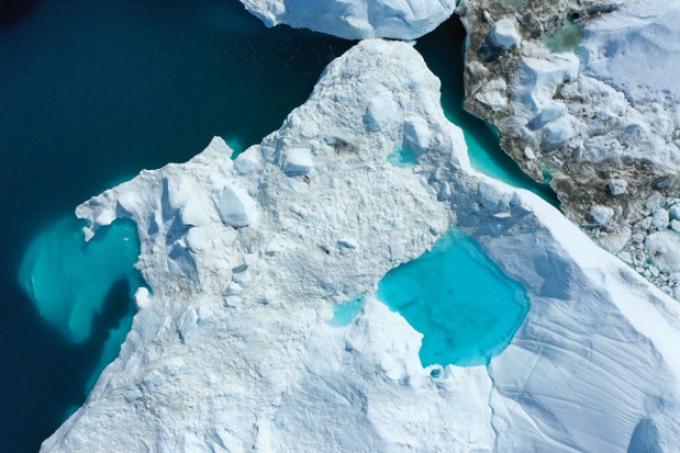Le photographe Casper Rolsted a réalisé une magnifique vidéo de ce fjord glaciaire en constant mouvement.
Le fjord glaciaire d’Ilulissat au Groenland en un étonnant time lapse
Le fjord glaciaire d’Ilulissat, aussi appelé Sermeq Kujalleq en groenlandais, est situé à l’ouest du Groenland. Il est l’un des phénomènes naturels les plus particuliers au monde. Il figure sur la liste du patrimoine mondial de l’UNESCO depuis 2004. Il s’est formé au cours de milliers d’années à mesure que la glace flottante s’est frayée un chemin dans les rochers. Le fjord mesure à l’heure actuelle quatre à six kilomètres de large sur septante kilomètres de long, mais en raison du réchauffement climatique, il continue de croître constamment. Le fjord de glace est rempli d’icebergs qui s’effondrent.
Le photographe Casper Rolsted a réalisé une magnifique vidéo de ce fjord glaciaire en constant mouvement.
video1.0Vimeohttps://vimeo.com/Ilulissat Icefjord – Timelapse Film from GreenlandCasper Rolstedhttps://vimeo.com/casperrolsted1plus
Vous pouvez modifier vos choix à tout moment en cliquant sur « Paramètres des cookies » en bas du site.
Photographer: Bo Normander
https://www.Naturtanken.com
https://www.Facebook.com/bonormander
Timelapse editor and sounddesigner: Casper Rolsted
https://www.CasperRolsted.com
https://www.Instagram.com/CasperRolsted
https://www.Facebook.com/CasperRolsted
https://www.Vimeo.com/CasperRolsted
ILULISSAT ICEFJORD – Greenland
Ilulissat Icefjord is a natural site of outstanding beauty created by inland ice and gigantic icebergs from the Sermeq Kujalleq glacier at the head of the fjord. In 2004, Ilulissat Icefjord was included on the UNESCO World Heritage List, hence achieving the highest international recognition for nature of irreplaceable value. The purpose of the World Heritage List is to protect the world’s cultural and natural heritage from destruction and stringent requirements are enforced to be admitted to the list.
The Icefjord is 4 to 6 km wide and 70 km long. It is shaped like an elongated trough formed by drifting glacial ice that has cut deep into the bedrock for millennia like a river of gravel, stone, and ice. The fjord is over a thousand metres deep but at the mouth of the fjord, where it meets Disko Bay at Sermermiut south of Ilulissat, the largest icebergs run aground on the Iceberg Bank as the fjord here is only 200 to 300 metres deep. The banks were made up in pre-historic times by glacial deposits of stone and eroded material. It is an amazing view from Sermermiut overlooking the stranded icebergs – the largest of which can extend up to 100 metres above sea level.
Over the past ten years, the Sermeq Kujalleq glacier has doubled its speed so that today it moves at about 40 metres per day. That makes it one of the world’s fastest glaciers. It calves an impressive 40 to 50 cubic kilometres of ice a year, equivalent to one tenth of the total production of icebergs from the Greenland ice sheet. If this amount of ice was melted it would provide enough water to cover all of the United States’ annual water consumption.
The largest icebergs from Sermeq Kujalleq are up to 1.5 cubic kilometres with a height of up to 120 m above sea level. However, the majority of an iceberg, over 80% of its mass, is located below sea level.
The Sermeq Kujalleq glacier contributes to a rich marine environment in several ways. The melt-water from the glacier ice contains varying quantities of nutrients and the icebergs create turbulence in the water column when they melt or turn around. This brings relatively warm and nutrient-rich water from deeper layers to the surface. Along with the tide, which is up to three metres between high tide and low tide, these conditions create a dynamic environment that enhances planktonic growth, which in turn attracts fish and sea mammals. The Icefjord is particularly known for its fine stocks of halibut. The icebergs also make large parts of the fjord unreachable and therefore wildlife is relatively well protected from hunting and fishing.
ILULISSAT ISFJORD – Grønland
Ilulissat Isfjord er et enestående naturområde skabt af gigantiske isfjelde fra den store Sermeq Kujalleq-gletsjer i bunden af fjorden. I 2004 blev Ilulissat Isfjord optaget på UNESCOs liste over verdensarv og opnåede dermed den højeste internationale anerkendelse for natur af uvurderlig værdi. Formålet med UNESCOs liste er at beskytte verdens kulturarv og naturarv mod ødelæggelse, og der stilles høje krav for at blive optaget.
Isfjorden er 4-6 km bred og 70 km dyb. Den er som et meget langt trug skabt af isfjelde, der gennem årtusinder har skåret sig dybt ned i fjeldet som en flod af sten og is. Fjorden er over tusind meter dyb, men ved udmundingen i Diskobugten, nær Sermermiut syd for Ilulissat, støder de største isfjelde på grund på Isfjeldsbanken. Der er vanddybden nemlig kun 2-300 meter på grund af massive aflejringer af sten og eroderet materiale. Det er et fantastisk syn at stå ved Sermermiut og se ud over de strandede isfjelde, hvoraf de største rager næsten 100 meter op.
Sermeq Kujalleq-gletsjeren har de seneste 10 år fordoblet sin hastighed, så den i dag bevæger sig med omkring 40 meter i døgnet. Det gør den til en af verdens hurtigste gletsjere. Den kælver imponerende 40 til 50 kubikkilometer is om året, svarende til en tiendedel af hele produktionen af isfjelde fra Grønlands indlandsis. Smeltede man denne ismængde, var der nok vand til at dække USAs årlige vandforbrug.
De største isfjelde fra Sermeq Kujalleq fylder 1,5 km3. Hovedparten af et isfjeld (mindst 80%) befinder sig under havoverfladen. Der er målt isfjelde, der rager helt op til 120 m over havoverfladen.https://i.vimeocdn.com/video/819896409_295x166.jpg295166https://i.vimeocdn.com/filter/overlay?src0=https%3A%2F%2Fi.vimeocdn.com%2Fvideo%2F819896409_295x166.jpg&src1=http%3A%2F%2Ff.vimeocdn.com%2Fp%2Fimages%2Fcrawler_play.png2019-10-05 04:31:09364460353/videos/364460353
